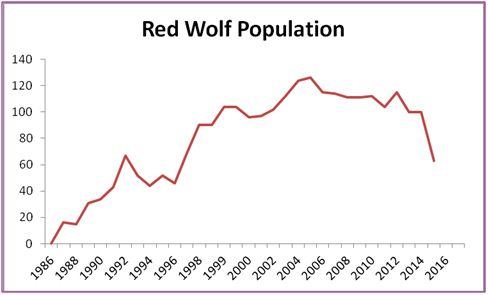
Fate of World’s Last 45 Red Wolves in the Wild in Hands of U.S. Fish & Wildlife Service

The U.S. Fish & Wildlife Service (USFWS), which has been managing a recovery operation for the critically endangered red wolf, will decide the fate of the species this month. Just 45 animals remain in and near the Alligator River National Wildlife Refuge in North Carolina.

Most Americans are familiar with the majestic gray wolf, which has made a remarkable comeback due to conservation efforts. Although populations are far lower than pre-colonial times, today there are about 5,000 in the lower 48 and 7,000 to 11,000 in Alaska. Canada is home to a thriving population of up to 60,000 wolves. In North America, Arctic wolves inhabit the tundra of Alaska and Canada, Mexican gray wolves were once endemic to Mexico and the American Southwest, and red wolves roamed the American Southeast. There is debate among scientists whether these are separate species.

Predator control programs and loss of habitat decimated red wolf populations. They were listed as an endangered species in 1973, and declared extinct in the wild by the USFWS in 1980. Prior to that, 17 animals had been placed in a captive breeding program at the Point Defiance Zoo and Aquarium in Tacoma, Washington. This allowed the reintroduction of red wolves to the North Carolina refuge in 1987 and later to additional areas in North Carolina, South Carolina, Tennessee and islands off the Atlantic and Gulf coasts.
As a result of the captive breeding program and reintroduction, wild red wolf populations increased throughout the 1990s and early 2000s, peaking at 130 animals in 2006. Populations then went into decline, followed by a severe crash beginning in 2014. The only surviving population is in the Alligator River National Wildlife Refuge.
In March of 2016, the Center for Biological Diversity filed suit against the USFWS for violating the Endangered Species Act, claiming mismanagement of the reintroduction program. In its press release issued at the time the suit was filed, the organization stated, “Bowing to political pressure, the Fish and Wildlife Service has stopped virtually all aspects of the recovery program for red wolves and is conducting a ‘feasibility review’ as a pretext to further dismantle the program.” It is the result of that study that is expected to be announced this month.
“It’s simply jaw-dropping that the U.S. Fish and Wildlife Service is consciously deciding to issue a death sentence—knowingly allowing a wolf found only in the United States to go extinct,” Leda Huta, executive director of the Endangered Species Coalition, said. “The red wolf has been one of our greatest wildlife success stories and could be again. It is a day I never thought I’d see.”
Results of a poll of North Carolina voters released on Aug. 17 showed that 73 percent support red wolf recovery efforts. The numbers were almost identical among registered Republican and Democratic voters. Following that, on Aug. 29, 27 members of the North Carolina legislature signed a letter to the Secretary of the Interior expressing “grave concerns” about the actions of the USFWS. The letter asks that the USFWS be directed to resume and improve the recovery program.
Red wolves are generally smaller than gray wolves, growing to about 4.5-5.5 feet long, including the tail. Adults will weigh 50 to 80 pounds. They have a lifespan in the wild of just six to seven years.
Earlier this year, I had the opportunity to photograph two red wolves at the Wolf Conservation Center (WCC) in New York. The WCC has been part of the captive breeding program since 2004 and two litters have successfully bred there. One has returned to the wild, and 10 are currently at the WCC. They inhabit a large, fenced enclosure and fiercely patrol the perimeter of their area.
Seeing these wolves up close creates a connection to their place in nature and an understanding of why they need the help of the reintroduction program. Aside from the 45 animals in the wild, there are now about 200 in various captive breeding programs across the U.S.

The USFWS has been criticized for repeated attempts to delist gray wolves from protection. In 2003, they began reducing protection for wolves until stopped by court action. In 2009, hunting was allowed in the Northern Rockies and Western Great Lakes. Even though that was overturned, in 2011, the USFWS came back with another effort to remove protections in the region. Meanwhile, Congress removed protection for wolves in all of Montana and Idaho, the eastern third of Washington and Oregon, and a small portion of northern Utah.
Today, we are witnessing the massacre of the Profanity Pack of 11 gray wolves in northeast Washington. The killing is in response to rancher’s complaints about cattle predation, but a study release last Thursday showed little scientific justification for such killings. The study looked at previous research on the effectiveness of killing predators to prevent livestock losses. They found that most of these studies showed that eliminating predators either didn’t stop attacks or actually increased predation. The researchers recommended “that policy makers suspend predator control efforts that lack evidence for functional effectiveness and that scientists focus on stringent standards of evidence in tests of predator control.”
For now, the fate of the last 45 wild red wolves is in the hands of the USFWS.

 233k
233k  41k
41k  Subscribe
Subscribe 